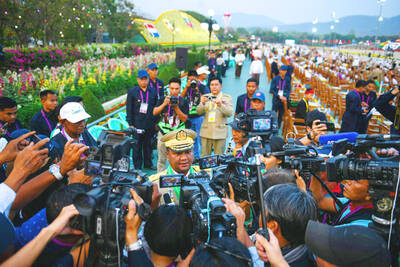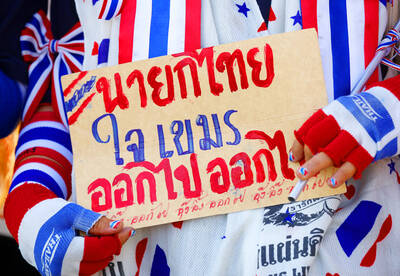This Eid al-Fitr Muslim holiday, Malaysian Sharifa Ahmad is determined to make heads turn in her “Made in Indonesia” outfit —a black flowing chiffon robe with embroidered neckline and matching headscarf hand stitched with Swarovski crystals.
“The dress is perfect for the holy day — modest yet elegant. I’m definitely going to rock my little black Islamic dress,” the 35-year-old civil servant said.
Ahmad is among a growing number of Muslim fashionistas across the region who visit Indonesia to splurge on new festive clothes to celebrate the end of the Ramadanh on Friday.

PHOTO: AFP
The country’s Islamic fashion industry reported a spike in sales of between 20 percent and 30 percent as early as June, thanks mainly to buyers like Ahmad from Malaysia and Singapore, retailers said.
Busloads of women flock to textile markets in cities like Jakarta and Yogyakarta to buy fabric, ready-to-wear dresses and headscarves, textile seller Azizah said.
“They will come in tour buses, choose what they like and buy 10 to 20 pieces of fabric. When they return to their countries, some telephone us to place more orders,” she said.
Ahmad flew on a budget airline from Kuala Lumpur in July, bought the fabric at a textile market in Jakarta and sent it to an Indonesian seamstress “to work her magic” before getting an friend to post it to her in Malaysia.
“I paid 600,000 rupiah [US$66 dollars] for it, half of what I would pay if I had it made in Malaysia. It’s a bargain for designer quality,” she said.
Chiffon, silk and crepe fabrics draping the silhouette in softer pastel colors, highlighted by delicate embellishments on the neck lines, are top fashion picks this year. Plainer headscarves strewn with Swarovski crystals replaced last year’s heavily embroidered beehive and turban craze.
“Some people shop for themselves. Others buy to resell. They would buy 10 yards of fabric of the same design in three colors, tailor the dresses here and sell them at a higher price in their boutiques back home,” textile merchant Vishal Kumar said.
Hoping to cash in on one of the most important dates on the Islamic calendar, Islamic fashion designer Dian Pelangi flew to Cairo, Abu Dhabi, London, Australia and Malaysia several months ago to hawk her wares. She said she sold “thousands” of pieces from her Eid collection at exhibitions in those countries for about 2.5 million rupiah each.
“Arab women are glamorous. They love their bling. My Islamic brown robes with hand-drawn batik detail at the bottom were sold out. Those with beadwork and rhinestones were also popular,” she said.
“Middle Eastern customers don’t bargain much and when they like something, they buy a lot. Some buy 20 to 30 pieces at one go. It’s a very lucrative market,” Pelangi said.
Sales of her Islamic dresses, priced from US$20 to US$300, tripled in July and jumped 10 times last month as local buyers joined in, she said.
Indonesia offers lower prices, quality workmanship, creativity in design and a variety of fabrics, from batik and ikat weaving to gold-threaded songket.
Hassan Marican, director of Singaporean company Second Chance Properties, said it imported 20 percent of its ready-made festive dresses from Indonesia and sold them at double the cost price.
“We buy from Indonesia because it’s cheap. For us businessmen, it all boils down to the price. Also we want some embroidery and beadwork. Our suppliers in China and Malaysia can’t provide that,” he said. “For Islamic fashion, Malaysia and Singapore always look to Indonesia for pointers. They’re very creative. Their headscarf designs are unmatchable.”
Industry Minister MS Hidayat said export of textiles and textile products this year was projected to reach US$10 billion, up from US$9.26 billion last year, or about 8 percent of total exports.
While fashion creations represented only a small fraction of those exports, there is great room for expansion, he said.
“Fashion products have great potential to be developed. We’re rich in natural resources and cultural heritage which can be inspiring and spur creativity,” he said.
He hopes Indonesian designers can help change the world’s perception that Islamic attire is dull, stuffy and unfashionable.
“Sometimes when you mention Muslim or Islam, people develop an allergy. They think it’s a very scary religion,” Indonesian Fashion Designers Association chairman Taruna Kusmaryuda Kusmayadi said.
“Islamic attire can be both modest and stylish. And also fun. They aren’t worn only during special Islamic days by country folks who read the Koran day and night. Modern city women wear them too while filling up gas for their BMWs,” he said. “Islamic fashion is borderless.”

Eleven people, including a former minister, were arrested in Serbia on Friday over a train station disaster in which 16 people died. The concrete canopy of the newly renovated station in the northern city of Novi Sad collapsed on Nov. 1, 2024 in a disaster widely blamed on corruption and poor oversight. It sparked a wave of student-led protests and led to the resignation of then-Serbian prime minister Milos Vucevic and the fall of his government. The public prosecutor’s office in Novi Sad opened an investigation into the accident and deaths. In February, the public prosecutor’s office for organized crime opened another probe into

RISING RACISM: A Japanese group called on China to assure safety in the country, while the Chinese embassy in Tokyo urged action against a ‘surge in xenophobia’ A Japanese woman living in China was attacked and injured by a man in a subway station in Suzhou, China, Japanese media said, hours after two Chinese men were seriously injured in violence in Tokyo. The attacks on Thursday raised concern about xenophobic sentiment in China and Japan that have been blamed for assaults in both countries. It was the third attack involving Japanese living in China since last year. In the two previous cases in China, Chinese authorities have insisted they were isolated incidents. Japanese broadcaster NHK did not identify the woman injured in Suzhou by name, but, citing the Japanese

RESTRUCTURE: Myanmar’s military has ended emergency rule and announced plans for elections in December, but critics said the move aims to entrench junta control Myanmar’s military government announced on Thursday that it was ending the state of emergency declared after it seized power in 2021 and would restructure administrative bodies to prepare for the new election at the end of the year. However, the polls planned for an unspecified date in December face serious obstacles, including a civil war raging over most of the country and pledges by opponents of the military rule to derail the election because they believe it can be neither free nor fair. Under the restructuring, Myanmar’s junta chief Min Aung Hlaing is giving up two posts, but would stay at the

YELLOW SHIRTS: Many protesters were associated with pro-royalist groups that had previously supported the ouster of Paetongtarn’s father, Thaksin, in 2006 Protesters rallied on Saturday in the Thai capital to demand the resignation of court-suspended Thai Prime Minister Paetongtarn Shinawatra and in support of the armed forces following a violent border dispute with Cambodia that killed more than three dozen people and displaced more than 260,000. Gathered at Bangkok’s Victory Monument despite soaring temperatures, many sang patriotic songs and listened to speeches denouncing Paetongtarn and her father, former Thai prime minister Thaksin Shinawatra, and voiced their backing of the country’s army, which has always retained substantial power in the Southeast Asian country. Police said there were about 2,000 protesters by mid-afternoon, although